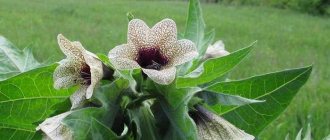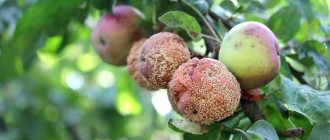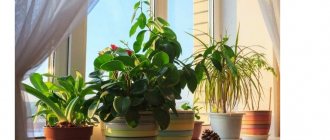Advanced summer residents, before developing a new site, begin to determine the chemical composition of the soil. This is done very correctly! After all, there are often situations when, despite carrying out all the necessary activities and lovingly caring for the beds, it is not possible to obtain the desired result when growing a certain crop. Of course, it’s easier to blame weather conditions, the wrong variety, diseases or lack of nutrients. Not everyone will think that perhaps the acidity of the soil, which is not suitable for your crops, is to blame.
Description of acidic soils 2. What conditions does pH depend on 3. Types of soils 4. Plants for acidic soils 4.1. Plants in the garden 4.2. Which indoor plants love acidic soil 5. Ways to increase acidity
Photo: Oddly enough, many plants prefer acidity.
Characteristics of acidic soils
pH - these letters are found in recommendations for the cultivation of almost any crop or variety. What is this designation and why do you need to know it? They indicate the acidity of the soil - a very important indicator for any vegetation. Let's figure out how it affects the growth and development of all crops, and establish an attitude towards the acidity of various home or garden plantings.
Soil acidity is the state of the soil when it acquires the properties of various acids. It depends on the presence of hydrogen ions in it. An important role here is also played by the content of aluminum, which oxidizes it. Experimental studies have established that there are much more acidic soils in the vast territory of our country than alkaline ones. This is especially true for our middle zone.
Why is it important to know acidity levels? The fact is that a huge number of chemical and biochemical processes in our environment, including soil, depend on acidity values.
| Important. This soil characteristic is of great, often paramount, importance for the normal development of cultivated plants. |
In order to grow full-fledged healthy plants and always have good harvests, it is imperative to monitor acidity levels, since the ability of green plants to absorb nutrient ions from the soil solution depends on it.
Such soils have an inhibitory (depressing) effect on the growth of the root system, thereby slowing down its absorption capacity. As a result, the supply of phosphorus, magnesium, potassium, calcium - the main vital elements - to plant organisms is significantly reduced, and, as a result, plants do not receive the necessary nutrition. On alkaline soils, it is difficult to supply plants with microelements: magnesium, zinc and boron. Soil microorganisms, so necessary for structurization, work only in an environment with slightly acidic characteristics.
Photo: Acidity levels need to be monitored.
The most favorable conditions for the required plant nutrition are considered to be soils with neutral indicators or not far from them. In other conditions, there is an excess absorption of some nutrients and a deficiency of others. As a result, there is a deficiency of certain elements that negatively affect the development of plants, the formation of the crop and its quality.
This is only a small part of the usefulness of pH knowledge. They will help you start developing the site in a timely manner and correctly distribute your efforts and funds for the purchase and application of fertilizers, the need for liming, and the correct selection of garden or garden crops.
Recommendations for planting
Many cultivated and fruit plants need to be planted in soil with a certain acidity, so experts recommend initially determining what the acidity of the substrate is in the areas where it is planned to grow healthy plants. There are several options.
Weeds. Yes, it is weeds that make it possible to accurately determine the composition of the soil. Although exceptions are possible, so this method should not be trusted 100%. Alfalfa and nettles living in the garden or garden indicate that the soil is alkaline. And plants such as mint, horse sorrel, moss, buttercup, woodlice indicate that we have soil with a high level of acidity.
Popular articles What is wrong with a rose and how to cure it correctly?
Devices. To determine soil type today, pH meters are used
They determine the level of alkalinity, while attracting attention with their portability. To use this device, first you need to remove the garbage, choose a place and moisten it with water, wait until the ground is moistened
Before use, the rod of the device should be wiped with a cloth, then stuck into the ground, and the depth should be at least 15 cm. To increase the level of truthfulness, it is worth using several tests, and it is advisable to conduct them in different corners of a certain territory, and then display the average value.
Litmus papers. They can be bought in flower shops. To begin with, it is recommended to dig a hole at least 25 cm deep to get a few grams of soil, and it is recommended to take the soil from a vertical layer. To determine the acidity of the soil, you will need distilled water, but if it is not possible to purchase it, then you should thoroughly boil ordinary water. If the acidity test paper does not change color after contact with water, then it is suitable for this procedure. Pour some earth into a bag and lower it into previously prepared water, leave for no more than 15 minutes. Please note that the amount of water should be five times more than soil. Next, a strip is lowered into the liquid, which, when interacting with water, will begin to change its color. Afterwards, the indicator must be compared by color with the scale located on the box.
If you want to plant plants that prefer soil with high acidity, but it is, on the contrary, low, then you need to use the following solutions to increase it:
- add peat;
- dig up the ground with humus or manure;
- use urea, since it also acts as a mineral fertilizer.
When acidity increases, there is no need to act jerkily, as this will have a detrimental effect on the well-being of plants that are already growing in this area.
If plants are not able to grow in soils with high acidity, the optimal solution for them is slightly acidic soils, then it is recommended to use one of the following methods:
- ash is an excellent means of reducing pH levels;
- adding lime, the calculation is as follows: 200-250 grams of lime are required per 1 m²; it can be replaced with dolomite flour or chalk;
- various professional preparations for soil deoxidation;
- sow green manure grasses, which include legumes, mustard, lupine, rye, phacelia, alfalfa, and so on.
You can learn about what grows well and blooms beautifully in acidic soils from the video below.
What affects acidity
What conditions does pH depend on? Or, more correctly, what influences this indicator to a greater extent? First of all, the climate in a given area, the proximity of peat bogs or forest areas, the lack or excess of water resources, as well as the care of this area and proper agricultural technology.
Let's consider what digital indicators indicate the level of acidity.
- The most significant number in this matter is 7 (more precisely 6.5–7.4), indicating a neutral character. All indicators below this figure, up to a value of 4.5, indicate an acidic character (from a slightly to strongly acidic reaction of the soil solution).
Photo: Each culture has its own requirements.
- Values in the range of 7.5–8.5 indicate alkaline types. Consequently, the farther the digital values in your soil analyzes are from the average values (7), the stronger the reaction of the soil solution towards the extreme boundaries, i.e. very acidic or very alkaline.
- When starting gardening, it is important to know that each type of plant has its own special requirements for the reaction of the soil environment. All garden plants can be divided into three groups according to their pH requirements: acidophiles (pH 5.0–6.4), neutrophils (pH 6.5–7.4), basiphiles (pH 7.5–8.5).
Carnation
There are many varieties of perennial carnations. Some of them feel great on acidic soil. Others prefer neutral, but they also tolerate high acidity.
If you notice that the flowers look much more modest than in the photo, perhaps the reason is excessive acidity. In this case, the soil should be alkalized.
What plants are grown in soils of different acidity?
A roughly established classification of the main agricultural and indoor crops depending on the requirements for the reaction of the soil solution will make your search easier:
- On neutral or slightly alkaline (pH 7.0–8.0) soils, asparagus, onions, celery, cabbage plants (cauliflower), mustard, parsley, as well as raspberries, peonies, and delphinium thrive.
- On neutral and slightly acidic soils (pH 6.0–7.4), almost all vegetables will bear fruit with gratitude: carrots, radishes, cucumbers with other pumpkins, legumes (peas, beans), spinach, beets, lettuce, garlic and the main part nightshades (tomatoes, eggplants, bell peppers). In addition, currants, red currants, sea buckthorn, gooseberries and most stone fruits love such areas. They are favorable for the bulk of garden flowers.
- Pome fruits, black currants, honeysuckle, strawberries, potatoes, lilies, and phlox grow well on slightly acidic soils (pH 5.5–6.0).
- Corn, raspberries, blackberries, watermelons, melons, and radishes are placed on medium-acid ones.
Photo: Black currant prefers slightly acidic soils.
It should be borne in mind that there are often plants that perfectly tolerate various environmental conditions, adapting and changing their properties. An example of this is the large-leaved hydrangea flower. By the color of the flowers, you can understand what level of acidity she has chosen: in an acidic environment, the color of the flowers is blue, in an alkaline environment - pink, in a neutral environment - white-beige. Therefore, it is easy to control the color of the flowers you like.
| Reference. Acidity tolerance may change as plants age. Young plants are most sensitive to this indicator. An acidic environment has the most powerful effect on plant organisms at the beginning of the growing season. Please note that for many garden crops, failure to comply with the necessary conditions for the level of soil acidity can be disastrous. |
However, acidic soil is not always a problem. The list of plants that love acidic soil is quite extensive. Consequently, from such plants it will be possible to easily create completely decorative areas, forming a unique landscape. Soils with pH values in the range of 5.5–6.5 are most preferable for these crops.
Gypsophila paniculata
Gypsophila paniculata, or kachim (Gypsophila paniculata) is a very lacy perennial plant from the Clove family; It is native to Europe and Asia. There are varieties with double and pink inflorescences. In addition to gypsophila paniculata in landscape flower beds, for “unloading” compositions, G. elegans and G. repens, and their varieties, are of interest.
Secrets of cultivation
Gypsophila loves dry, carbonate, light loamy or sandy loam, well-drained soils, on which it “floats”, creating “white flower clouds” during the flowering period; in this “art” only downy spurge can compete with it. It can grow in one place for more than 25 years, and it will have to constantly add lime to the soil and mulch the plantings. Sowed in open ground in April-May or before winter.
What plants like acidic soil: list
Let's look at a situation where you have a plot with acidic soil, and there is no possibility, and sometimes no desire, to correct this situation in the near future. Don't be upset. There is always a way out! It turns out that there are a significant number of plants that love it. Here are some of them.
Photo: Garden azalea also loves “sourness”.
What plants like acidic soil in the garden?
Such acidophilic plants, also called acidophytes, include almost all conifers, forest berries (blueberries, lingonberries, as well as medicinal blueberries and cranberries), azaleas, wild rosemary and many other representatives of the plant world.
Ferns
Plants that inhabit acidic areas everywhere. Their most common representative is the decorative multi-row spiny plant, which has an attractive spreading bush.
Shrubs
Rhododendrons are widespread across our vast territory - tall, up to two meters, shrubs that are pleasing to the eye from April to July, as well as their late varieties such as rhododendron Veresk, low, no more than half a meter in height, growing until the month of October. Most of their representatives are winter-hardy, but there are specimens that require special shelters in harsh climates.
Flowers
Everyone's favorite peonies prefer acidic soils, with very low pH values. In such beds, the flower grows well up to 1.5 m, bushes and pleases us with lush color. Perhaps for this reason it is not possible to grow your favorite flower in your area.
Photo: The more acidic the soil, the better for lupine.
Lupine simply loves such soils. Moreover, the more sour, the better. In such conditions, it can grow up to a meter or even higher, and is also an excellent green manure.
Forget-me-nots and lilies of the valley also grow well in such places. Lilies can also be placed in acidic areas. True, not all, but only Asian hybrids.
It may come as a surprise to some that the queen of flowers, the rose, simply loves sour areas. Try to please the rose bushes, add special acidifiers to the soil. However, there are some varieties with other soil preferences. Therefore, be careful. Read the characteristics of the variety before purchasing in a store or nursery.
Photo: And roses like this soil!
Poppies, purslanes, various carnations, which grow quickly in June-August, being an excellent honey plant, attract pollinating insects. It does not react at all to the high acidity of zinium, regardless of the wide variety of its types.
Trees
You can plant coniferous trees of any kind, creating a wonderful corner for relaxation. Both stylish and reasonable.
Vegetables
Surprisingly, the most popular garden crop, potatoes, also prefers a pH level of less than 6.0. If, during harvesting of this crop, a large number of root crops infected with scab disease are noted, it is time to conduct an acidity test.
Which houseplants like acidic soil?
Indoor plants: azaleas, camellias, fuchsia, cyclamen, monstera, begonia, pelargonium, asparagus also prefer non-alkaline soils. To plant them, you should prepare a substrate with a predominance of peat (preferably high peat) and compost obtained from rotted coniferous or oak leaves. For even greater acidity, sphagnum moss can be successfully used.
However, most of us prefer to buy soil from the store. The packaging must contain a mark indicating the acidity value. You can also acidify the soil using sawdust, pine litter, and fresh manure. Other home methods for this are also applicable: using lemon or sorrel, as well as ordinary citric acid - dissolve 15 g in a liter of water.
Avens
Almost any variety of gravilate is unpretentious to the planting site. This culture prefers loose and fertile soil with normal acidity. Gravilat also grows well in slightly acidic areas.
You can add some peat and compost to the flowerbed. Experienced gardeners sprinkle wood ash next to the plant. This method will allow you to feed the gravilate and protect it from pests.
How to increase soil acidity
Sometimes, but extremely rarely, there is a need to increase the pH. Although it usually happens the other way around. But for example, you really want to have an avid acidophyte on your site. What to do? Bring in acidic peat and use it as an organic fertilizer, mixing it with the existing soil in an area pre-designated for your intended pet. There are other ways to make an area more acidic:
- add acidic complex fertilizers, the choice of which is huge in stores, and any seller will help you;
- add compost or manure, which will help to slowly acidify the soil;
- simultaneously with digging, add waste from coniferous trees: shavings, sawdust, litter;
- use urea - one of the fastest acidifiers.
| Advice. Before drawing up a planting plan on your site, be sure to take into account the acidity of the soil solution. Do not rush into carrying out special work on liming the entire area. Take this fact into account when placing crops that prefer acidic soils |
______________________________________________________________________________________________ Read our other articles about soils: How to choose good soil for plants
Growing seedlings on coconut substrate Growing seedlings on artificial substrates Vermiculite for plants: we use the substrate for the benefit of seedlings, indoor flowers and crops in the beds ________________________________________________________________________________________________ What kind of soil is in your garden? Share your answers with other gardeners in the comments.
Dicentra
Light and nutritious substrates are best suited for dicentra. In principle, it can grow on any soil.
The plant is planted in early spring, usually using pieces of rhizomes. After planting, the ground around is mulched with peat.
If the acidity level is slightly increased, the dicentra will grow and develop normally. It is planted by mixborders with other perennials, or separately, in a small group.
Weed infusion for feeding
How to prepare an infusion of weeds for feeding?
Fill the container with weeded weeds to 3/4 of its volume and fill it with water to the same level so that there is room for fermentation, otherwise the liquid will overflow during fermentation. Cover with film and tie it so that nitrogen does not evaporate from the container and oxygen does not enter it - it has been noticed that the best result is obtained with methane fermentation, that is, without access to oxygen.
After about two weeks, fermentation will be completed and the smell of a stable will appear - the infusion is ready. Dilute it with water 1:2 for root feeding and 1:5 for foliar feeding. At the same time, feeding weeds with an infusion disorients pests with their smell, and they do not touch their host plants, flying around the beds treated with an infusion of fermented weeds.
The remaining grounds can be put into compost, you can use it to mulch raspberries or pumpkin crops, covering the top with weeded weeds so as not to spoil the air with the smell of the stable. The smell can be significantly reduced if you add valerian along with the root to the container with weeds.
You can put wheatgrass along with roots, flowers of coltsfoot, dandelion, as well as all other weeds into the infusion. You should not put diseased plants in the infusion; it is better to burn them.
Where to put the thicket of fermented weeds?
In order not to bother with the grounds, you can tightly stuff old tights with weeds and lower them into the barrel, hooking them on the edge. Then the infusion will not clog the strainer at the watering can, and the tights along with the grounds should simply be buried under the apple trees along the perimeter of the crown. In a couple of years, only empty tights will remain, and all the filling will be used with apple tree roots. A barrel with a capacity of 200 liters will require 10 tights.
Moss
Moss (division Bryophyta) is the main lover of acidic soil. I love this fluffy velvety green rug. Many hobbyists plant a whole garden of different mosses. Several years ago, a good landscape design specialist advised me to carefully transplant the moss that had grown between the tiles along the path near the spruce tree or near the apple trees to the right place. Moss from the roof of grandma's old shed in the village is also perfect. It is better not to use forest moss on the site.
LiveInternetLiveInternet
-Music
—Categories
- display of goods (47)
- grocery (39)
- non-food (8)
- astronomy (36)
- knitting (42)
- cities, countries (33)
- dacha (1010)
- pests, beneficial (60)
- children (6)
- design, decor (84)
- inventory, tools (41)
- calendars, crop rotation, books (56)
- medicinal, green (32)
- vegetables (206)
- fruits and berries, conifers (42)
- crafts, tips (43)
- buildings, repairs (53)
- soil (15)
- fertilizer (56)
- companies (73)
- flowers (142)
- what to cook (32)
- berries (43)
- unusual (0)
- children (46)
- education (6)
- cartoons (12)
- training (16)
- school (1)
- for diary, box (40)
- blanks (70)
- adjikas, ketchups (9)
- jam, puree (6)
- freezing (8)
- pickling (23)
- pickling (31)
- salads, caviar (3)
- juices, drinks (4)
- drying (9)
- health (136)
- prevention (115)
- care (13)
- apartment (101)
- bathroom (7)
- children's (3)
- ideas (11)
- kitchen (7)
- clothes, shoes (5)
- repair (37)
- building materials (11)
- textiles (2)
- technology (6)
- cleaning (27)
- cooking (477)
- sandwiches (11)
- baked goods (72)
- for children (31)
- cereals, pasta (23)
- dairy, sour milk (14)
- meat (50)
- drinks (39)
- fillings, minced meat, cream (20)
- public catering. menu (79)
- vegetables (53)
- first courses (57)
- post (14)
- dishes (7)
- seasonings (14)
- fish (29)
- salads, cold appetizer (74)
- tips, lessons (13)
- dough (18)
- decoration, serving (11)
- fruits, berries (5)
- bread, lavash (10)
- eggs, caviar (12)
- music (24)
- unusual (77)
- news (68)
- useful tips. (0)
- holidays, religion (18)
- movies (122)
- history (25)
- history (82)
- feature films (17)
- chemistry (10)
- sewing (94)
- machine embroidery (2)
- children (11)
- for women (36)
- for windows (4)
- fashion, styles (18)
- miscellaneous (28)
- repair (7)
—Search by diary
—Subscription by e-mail
— Regular readers
—Communities
-Statistics
Kalina
Viburnum (Viburnum) is a small deciduous shrub and sometimes a small tree. For this plant, slightly acidic soil will be optimal; too acidic soil will not work. This plant is a godsend due to its decorative value in the spring, when the bush is strewn with umbrella-shaped inflorescences. And in the fall it has no equal at all. Bright red berries are like beads among colorful autumn foliage.
Almost all types of plants - forked viburnum, gourdovina viburnum, toothed viburnum, Canadian viburnum, common viburnum - develop well in slightly acidic soil. In addition, viburnum is an extremely useful plant that will help prevent some health problems or solve them using traditional methods.











